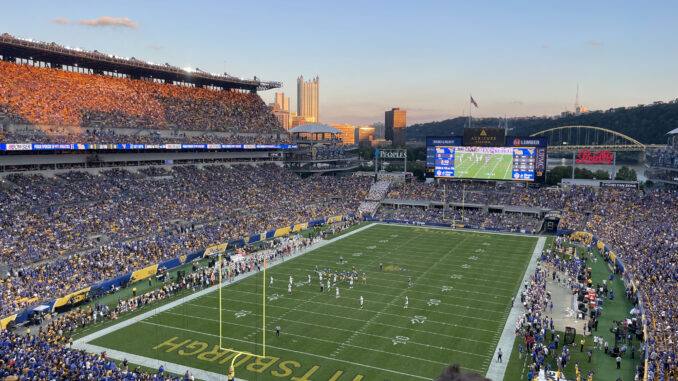
Luke Henne | Editor-in-Chief
Sept. 8, 2022
Pittsburgh and West Virginia squared off against one another in the “Backyard Brawl” at Acrisure Stadium on Sept. 1, kicking off the 2022 college football season for both programs.
The rivalry is regarded as one of the best in all of college football. That is, when it’s active.
The programs, which are separated by just 75 miles, exchanged trips to each other’s stadium in every season from 1962 to 2011, but then they went an entire decade without playing one another prior to the Sept. 1 contest, which saw Pitt win 38-31 in dramatic fashion on its home field.
The teams are set to meet in each of the next three seasons, as well as every season from 2029 to 2032. However, the future of the series beyond 2032 is unknown.
Why is that? How could such a historic rivalry be broken apart and only pieced back together by temporary non-conference contracts?
The obvious answer: conference realignment.
The first massive wave of conference shuffling in recent memory came in the early 2010s. The old Big East Conference — rooted in its success on the basketball court — watched in late 2011 as programs like Pitt, Syracuse and Notre Dame announced intentions to join the Atlantic Coast Conference to cash in on football television contracts and exposure. Not enough people cared about the Big East for its football teams, and the conference quickly looked different.
By 2012-13, West Virginia was in the Big 12 Conference. Pitt, Syracuse and Notre Dame were all ACC members by 2013-14, with Notre Dame remaining independent in football to maintain its television contract with NBC. Former Big East members like Louisville and Rutgers joined the American Athletic Conference for a season before transitioning to new conferences in 2014-15 (Louisville to the ACC, Rutgers to the Big Ten Conference).
While the non-FBS football members of the Big East like Georgetown, Villanova and St. John’s kept the conference intact in other sports, its football was gone. Perhaps forever.
Conference realignment has come to the forefront again in recent years. Texas and Oklahoma will leave the Big 12 to join the Southeastern Conference in 2025-26. Southern California and UCLA will depart from the Pacific-12 Conference and will become part of the Big Ten in 2024-25. Cincinnati, Houston, Brigham Young and Central Florida are set to join the Big 12 in 2023-24.
College conferences as we know them are dead. As a consequence of this realignment, rivalries are quickly dying as well.
It feels like it’s always been about the money. But now, it feels like money has taken even higher precedent over the true meaning of college football.
Why would a program want its games to air on ESPNews or the Pac-12 Network when they could air on CBS or FOX almost every week?
Sure, some rivalries kept within a conference will remain for now. Auburn and Alabama will meet in the annual “Iron Bowl” to cap off the SEC regular season. But what about the yearly “Bedlam Series” between Oklahoma and Oklahoma State? After 2024, who knows when the next time the two in-state rivals will meet.
The easy answer is that the teams can play in non-conference action. That’s not such an easy solution, however. There’s a reason Pitt and West Virginia went 10 seasons without playing.
It’s the same reason that Pitt and Penn State didn’t meet on the football field once between 2001 and 2015. These two schools, along with West Virginia, are all Power 5 programs that play extremely tough conference schedules.
Why would Penn State want to play a losable game against Pitt when they already play tough Big Ten opponents like Ohio State and Michigan on an annual basis? Instead, why not just secure easy wins at home against lower-caliber programs like Ohio and Central Michigan?
After all, the money pouring in from the Big Ten television contracts will look just the same, regardless of who the opponent is on Penn State’s schedule.
A world where Pitt and West Virginia are conference foes once again seems like a pipedream.
If the 70,622 fans — the record attendance for any sporting event in Pittsburgh history — that were at the Sept. 1 game at Acrisure Stadium had a voice in this fight, the historic rivalry between Pitt and West Virginia would’ve never ended in the first place.
It’s a shame that television contracts and money are dictating the future of the sport’s best rivalries.
Gear up for the NCAA’s newest rivalry: Rutgers against UCLA.

